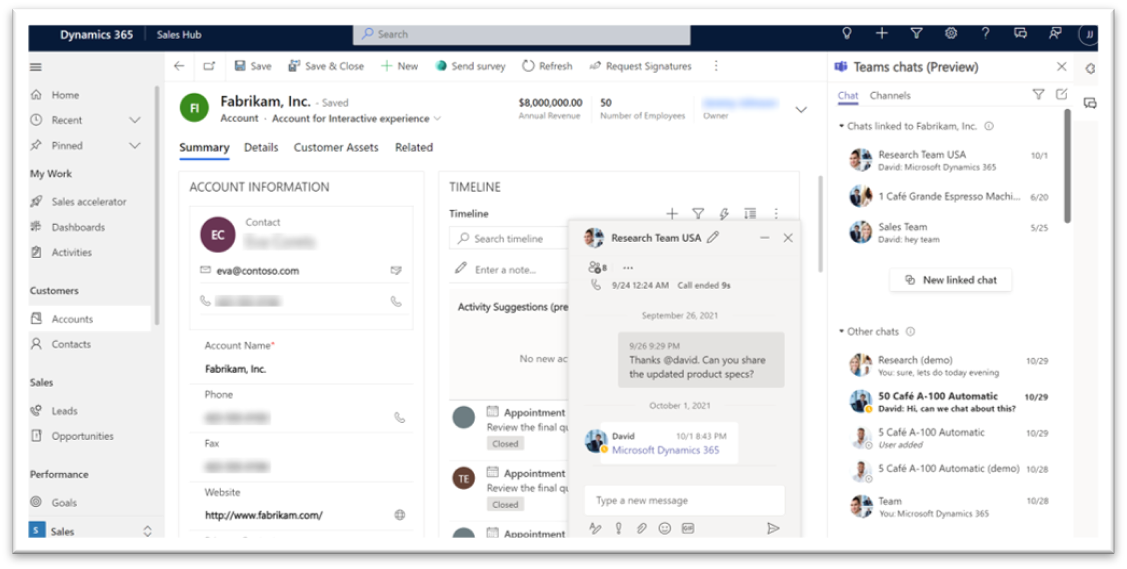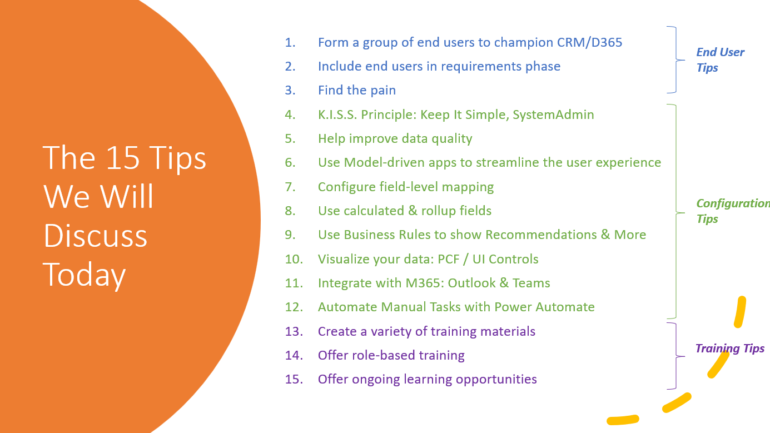Last week at Community Summit, I presented “15 Fantastic User Adoption Tips.” It was such a fun time and I truly enjoyed delivering the content and seeing all of the amazing learners who came to my session. In this blog, I’ll give you a high-level overview of the content we covered. Feel free to leave any questions in the comments below and I am happy to share more.

Some User Adoption Goals
Here are some goals you can keep in mind as you focus on increasing user adoption for your organization:
- Automate what you can.
- Simplify & streamline.
- Help guide users & standardize processes.
- Eliminate duplicate data entry points.
- Minimize required fields.
- Involve your users throughout the life of Dynamics 365.
15 User Adoption Tips
Well let’s dive in directly to the tips, shall we?

You’ll notice that I grouped the tips in three main areas: end user tips, configuration tips and training tips.
The Tips:
- Form a group of end users
Create a team of users to help guide your design, build and more. These users should include varied skill levels – not just your superstars. Look for your influencers. And be sure to involve this group right from the start and through all phases of your project.

- Include end users in requirements phase
Don’t forget to use this group to help determine your requirements. You need to see the system from their viewpoint, not just from the project team, stakeholders and management. Otherwise… your users are looking at butts because you never considered their view.

- Find the pain
There is a reason why users aren’t using your system. Your challenge is to find out why – find the pain and then use the technology in the Dynamics 365 and Power Platform to solve it. Hint: To help find the pain, look for any manual Excel reporting your users are currently doing.

- K.I.S.S. Principle: Keep It Simple, SystemAdmin
Apply strategies to simplify your system: streamline your business processes, minimize required fields on a form, select the correct field/column type, keep forms clean. Don’t overcomplicate your system.

- Help improve data quality
Don’t leave data quality for “phase two.” Here are some tools to help with data quality in your system: start with clean data, pick the correct field/column types, use field validation rules, include tooltips when adding new fields/columns, use field mapping (see tip #7 for more!), set up your own duplicate detection rules, and use 3rd party tools.

- Use Model-driven apps to streamline the user experience
I believe that a streamlined, simplified app for a specific user group is the most impactful configuration item you can implement that will positively impact user adoption at your organization. If you want to learn more, I have a lot of information both here on my blog and at my YouTube channel about model-driven apps. In short: they are amazing and I love building them and talking about them.

- Configure field-level mapping
Field mapping can be configured on the 1:N or N:1 relationship between two tables. It can only be set up in the Classic Solution Designer. It is one of the most under-utilized tool in Dynamics 365. Check this out to learn more about what you can do and how to implement field mapping.

- Use calculated & rollup fields
Out-of-the-box field types exist for calculated and rollup fields. A calculated field automates manual calculations and is supported on the following column/field types: text, choice, yes/no, whole number, decimal number, currency and date time. Rollup fields aggregate data using the following functions: sum, count, min, max, avg.
- Use Business Rules to show Recommendations & More
Business rules have been around since CRM 2013, and allow you to configure business logic without using custom code. This tip is specifically around Showing Recommendations – because I think it’s really powerful and I don’t see many organizations implementing it. Check out the image below that shows you the back end and the front-end in a model-driven app for Dynamics 365. You can also check out this 4-minute long video on how to set this up.

- Visualize your data: PCF / UI Controls
Apply controls on your forms, tables and views to help visualize your data and make it easier for your users to consume. Currently, table and view-level controls must be applied in the Classic Solution Designer. Field controls are applied on the form and can be done in either the maker portal or classic. Below are the field (column) controls currently available out-of-the-box. If you need more visualizations, check out pcf.gallery.

- Integrate with M365: Outlook & Teams
Implement and deploy the Dynamics 365 App for Outlook! With one click, you can quickly and easily track emails and meetings to Dynamics 365 / Power Apps records. Moreover, easily create new lead, account, case, contact and more from an Outlook email or meeting. In Teams, enhancements in collaboration blends the lines between Teams & Power Apps. Chat in Teams from a Power Apps record! View Dynamics data directly in a Teams channel! Lots more to come too.

- Automate Manual Tasks with Power Automate
Use Power Automate to craft powerful automations that reach well beyond the traditional borders of CRM (Sales, Customer Service and Marketing). With 830+ connectors, you can take action on many, many things. Check out my Power Automate 101 series if you want to learn more.

- Create a variety of training materials
People learn differently, and it’s important to differentiate your training materials to ensure you reach all learners. Want to learn more about learning styles? Check out my blog about it here.

- Offer role-based training
Group your users based on how they will use the system. Once you have your learners in specific job roles, make sure to provide only the appropriate training topics to them. Have one core training with all users. Then, have specific training topics for different roles.

- Offer ongoing learning opportunities
Avoid the “big bang” approach to training. Training isn’t over because you have gone live with the system. Continue to provide ongoing learning opportunities for your users. Try lunch and learns, tips and tricks, newsletters, podcasts, video libraries and more.

